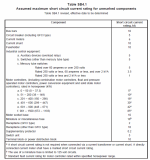wbdvt
Senior Member
- Location
- Rutland, VT, USA
- Occupation
- Electrical Engineer, PE
Just because there is a 10kA rated breaker upstream has no bearing on what the fault current is. That 10kA breaker may be series rated with the main breaker in the panel to be 22kA. So if you are saying that since a 10kA breaker is upstream from a non-fused disco, you are ok? Suppose the fault current is 12kA and that is why there is a series rated panel for the 10kA breakers to be rated higher.But my point is that most 30A equipment discos will have a 10k breaker upstream so there is no problem using an unfused disco. And by 'most' I mean 99.9%, at least in resi.
The point being unless some analysis is done of the system, you really have no idea if the non-fused disco is overdutied. An overdutied condition is a violation of NEC and OSHA.
When I do a study that involves arc flash, our labels have the available short circuit current for the equipment being labeled, printed right on the label. This way the electrician that may be replacing a breaker or installing a new circuit, can verify that the breaker purchased is adequate for the use.

